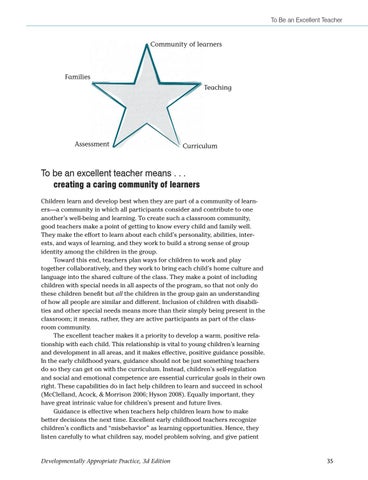To Be an Excellent Teacher
Community of learners
Families Teaching
Assessment
Curriculum
To be an excellent teacher means . . . creating a caring community of learners Children learn and develop best when they are part of a community of learners—a community in which all participants consider and contribute to one another’s well-being and learning. To create such a classroom community, good teachers make a point of getting to know every child and family well. They make the effort to learn about each child’s personality, abilities, interests, and ways of learning, and they work to build a strong sense of group identity among the children in the group. Toward this end, teachers plan ways for children to work and play together collaboratively, and they work to bring each child’s home culture and language into the shared culture of the class. They make a point of including children with special needs in all aspects of the program, so that not only do these children benefit but all the children in the group gain an understanding of how all people are similar and different. Inclusion of children with disabilities and other special needs means more than their simply being present in the classroom; it means, rather, they are active participants as part of the classroom community. The excellent teacher makes it a priority to develop a warm, positive relationship with each child. This relationship is vital to young children’s learning and development in all areas, and it makes effective, positive guidance possible. In the early childhood years, guidance should not be just something teachers do so they can get on with the curriculum. Instead, children’s self-regulation and social and emotional competence are essential curricular goals in their own right. These capabilities do in fact help children to learn and succeed in school (McClelland, Acock, & Morrison 2006; Hyson 2008). Equally important, they have great intrinsic value for children’s present and future lives. Guidance is effective when teachers help children learn how to make better decisions the next time. Excellent early childhood teachers recognize children’s conflicts and “misbehavior” as learning opportunities. Hence, they listen carefully to what children say, model problem solving, and give patient
Developmentally Appropriate Practice, 3d Edition
chapter1.indd 35
35
11/20/2008 10:22:03 AM
